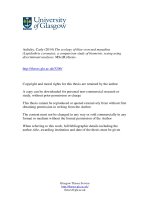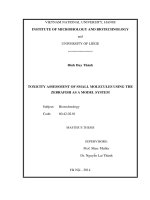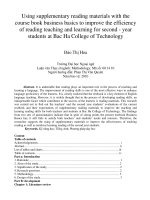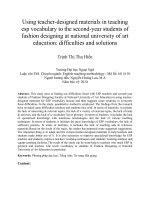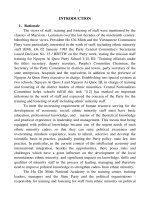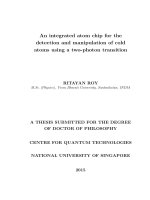Shear strengthening of reinforced-concrete beams using advanced composite materials
Bạn đang xem bản rút gọn của tài liệu. Xem và tải ngay bản đầy đủ của tài liệu tại đây (10.59 MB, 224 trang )
ÉCOLE DE TECHNOLOGIE SUPÉRIEURE
UNIVERSITÉ DU QUÉBEC
MANUSCRIPT-BASED THESIS PRESENTED TO
ÉCOLE DE TECHNOLOGIE SUPÉRIEURE
IN PARTIAL FULFILMENT OF THE REQUIREMENTS
FOR THE DEGREE OF DOCTOR OF PHILOSOPHY
Ph. D.
BY
Amir MOFIDI
SHEAR STRENGTHENING OF REINFORCED-CONCRETE BEAMS USING
ADVANCED COMPOSITE MATERIALS
MONTRÉAL, 31 JULY 2012
© Copyright 2012 reserved by Amir Mofidi
Library and Archives
Canada
Bibliothèque et
Archives Canada
Published Heritage
Branch
Direction du
Patrimoine de l'édition
395 Wellington Street
Ottawa ON K1A 0N4
Canada
395, rue Wellington
Ottawa ON K1A 0N4
Canada
Your file Votre référence
ISBN:
978-0-494-79149-3
Our file Notre référence
ISBN:
NOTICE:
978-0-494-79149-3
AVIS:
The author has granted a nonexclusive license allowing Library and
Archives Canada to reproduce,
publish, archive, preserve, conserve,
communicate to the public by
telecommunication or on the Internet,
loan, distrbute and sell theses
worldwide, for commercial or noncommercial purposes, in microform,
paper, electronic and/or any other
formats.
L'auteur a accordé une licence non exclusive
permettant à la Bibliothèque et Archives
Canada de reproduire, publier, archiver,
sauvegarder, conserver, transmettre au public
par télécommunication ou par l'Internet, prêter,
distribuer et vendre des thèses partout dans le
monde, à des fins commerciales ou autres, sur
support microforme, papier, électronique et/ou
autres formats.
The author retains copyright
ownership and moral rights in this
thesis. Neither the thesis nor
substantial extracts from it may be
printed or otherwise reproduced
without the author's permission.
L'auteur conserve la propriété du droit d'auteur
et des droits moraux qui protege cette thèse. Ni
la thèse ni des extraits substantiels de celle-ci
ne doivent être imprimés ou autrement
reproduits sans son autorisation.
In compliance with the Canadian
Privacy Act some supporting forms
may have been removed from this
thesis.
Conformément à la loi canadienne sur la
protection de la vie privée, quelques
formulaires secondaires ont été enlevés de
cette thèse.
While these forms may be included
in the document page count, their
removal does not represent any loss
of content from the thesis.
Bien que ces formulaires aient inclus dans
la pagination, il n'y aura aucun contenu
manquant.
THIS THESIS HAS BEEN EVALUATED
BY THE FOLLOWING BOARD OF EXAMINERS
Dr. Omar Chaallal, Thesis Supervisor
Department of Construction Engineering, École de Technologie Supérieure
Dr. Marie-José Nollet, Member of the Board of Examiners
Department of Construction Engineering, École de Technologie Supérieure
Dr. Vladimir Brailovsky, President of the Board of Examiners
Department of Mechanical Engineering, École de Technologie Supérieure
Dr. Yixin Shao, External Member of the Board of Examiners
Department of Civil Engineering, McGill University
THIS THESIS WAS PRESENTED AND DEFENDED
BEFORE A BOARD OF EXAMINERS AND PUBLIC
18 JULY 2012
AT ÉCOLE DE TECHNOLOGIE SUPÉRIEURE
ACKNOWLEDGMENTS
There are many people I must thank for their various forms of support and appreciation
towards me.
First of all, I thank my family. Their love, support and encouragement were essential for the
completion of my Ph.D. program.
I offer my sincere gratitude to my Ph.D. advisor, Professor Omar Chaallal. His excellent
advice, support and friendship have been invaluable on both an academic and a personal
level, for which I am extremely grateful.
I very much appreciate the efficient collaboration of Mr. John Lescelleur (senior technician)
and Mr. Juan Mauricio Rios (technician) at ÉTS structural laboratory, in conducting the
experimental tests.
I gratefully acknowledged the financial support of the Natural Sciences and Engineering
Research Council of Canada (NSERC), the Fonds québécois de la recherche sur la nature et
les technologies (FQRNT), and the Ministère des Transports du Québec (MTQ) through
Ph.D. scholarships.
I appreciate Sika Canada inc. (Pointe Claire, Quebec) and Pultrall inc. (Thetford Mines,
Quebec) for the donation of test materials to my Ph.D. research study.
SHEAR STRENGTHENING OF REINFORCED-CONCRETE BEAMS USING
ADVANCED COMPOSITE MATERIALS
Amir MOFIDI
ABSTRACT
This Doctorate program focuses on the shear strengthening of reinforced concrete (RC)
beams using fibre-reinforced polymers (FRP) composites. Several research problems related
to shear strengthening still linger and therefore require further research studies to be entirely
solved. The main objective of this program is to experimentally and analytically study the
FRP strengthening methods of full-scale RC T-section beams in shear. During this Ph.D.
program major aspects related to shear strengthening of RC beams with fibre-reinforced
polymers (FRP) sheets and rods are investigated as follows: 1) Shear strengthening of RC
beams with externally-bonded (EB) FRP-Influencing factors and conceptual debonding
model: On the basis of this effort, a new design approach is proposed to calculate the shear
contribution of the FRP considering the effect of the transverse steel (among other
influencing parameters) on the FRP contribution in shear resistance. The proposed model
shows the best correlation with experimental results in comparison with the current design
codes and guidelines; 2) Performance of end-anchorage systems for RC beams strengthened
in shear with epoxy-bonded FRP composites: The results of this study reveal that specimens
retrofitted with EB FRP methods and properly designed end-anchorage systems can achieve a
superior contribution to shear resistance compared to specimens strengthened using EB FRP
with no anchorage and Near-Surface Mounted (NSM) rebar method; 3) Shear strengthening
of RC beams with EB FRP- Effect of strip-width to strip-spacing ratio: An experimental and
analytical investigation with emphasis on the effect of strip-width to strip-spacing ratio on the
contribution of FRP (Vf) in shear strengthened of RC beams with EB FRP strips is carried
out; and 4) Behaviour of RC beams strengthened in shear using embedded through-section
(ETS) FRP rods method: A newly developed shear strengthening method is investigated
Embedded through-section (ETS) FRP rod method is a promising method for strengthening
RC beams in shear using FRP rods. In the ETS method, FRP rods are epoxy-bonded to predrilled holes through the cross section of the RC beams. The test results not only confirmed
the feasibility of the ETS method, but also revealed that the performance of the beams
strengthened using this method is significantly superior to that of the beams strengthened
with EB FRP and NSM FRP methods.
Keyword: Concrete beams, Fibre-reinforced polymers, Strengthening, Shear resistance.
RENFORCEMENT EN CISAILLEMENT DES POUTRES BÉTON ARMÉ À L’AIDE
DE MATÉRIAUX COMPOSITES AVANCÉS
Amir MOFIDI
RÉSUMÉ
Cette thèse de doctorat traite du renforcement en cisaillement de structures en béton armé
(BA) à l’aide de matériaux composites en polymère renforcé de fibres (PRF). De nombreuses
problématiques de recherche reliées au renforcement en cisaillement n’ont pas encore été
résolues à ce jour. L’objectif principal du présent est d’étudier expérimentalement et
analytiquement les méthodes de renforcement en cisaillement de poutres de section en Té en
BA à l’aide de PRF. Le programme considère plusieurs aspects majeurs reliés au
renforcement en cisaillement de poutres en BA à l’aide de tissus et de tiges en PRF, comme
suit: 1) Renforcement en cisaillement de poutres en BA à l’aide de PRF collé en surface (EB:
Externally Bonded) – Facteurs d’influence et modèle conceptuel de délamination: Sur la base
des résultats obtenus, une nouvelle approche de design est proposée pour le calcul de la
contribution au cisaillement du PRF tenant compte de l’influence de l’acier transversal (entre
autres) sur la contribution du PRF à la résistance globale. Le modèle proposé montre une
meilleure corrélation avec les résultats expérimentaux en comparaison aux codes et guides en
vigueur; 2) Performance de systèmes d’ancrage pour poutres en BA renforcées à l’aide de
PRF collé en surface: Les résultats de cette étude révèlent que les spécimens renforcés par la
méthode PRF EB avec des ancrages adéquatement conçus peuvent atteindre des
contributions à la résistance en cisaillement supérieures á ceux sans système d’ancrage et
ceux renforcés à laide de la méthode NSMR (Near-Surface Mounted Rebar) ; 3)
Renforcement en cisaillement de poutres en BA à l’aide de PRF EB: Effet du rapport largeur
sur espacement des bandes en PRF : Investigation expérimentale et analytique investigation
avec emphase sur l’effet du rapport largeur sur espacement des bandes en PRF sur la
contribution du PRF (Vf) dans les poutres renforcées en cisaillement à l’aide de bandes en
PRF EB est menée ; et 4) Comportement des poutres en BA renforcées à l’aide de la méthode
ETS (embedded through-section) : Une méthode novatrice développée pour le renforcement
en cisaillement est explorée. Cette méthode est très prometteuse pour le renforcement en
cisaillement. Dans cette méthode, des tiges en PRF sont insérées et scellées à l’aide d’époxy
dans des trous préalablement percés à travers l’âme de la poutre en BA. Les résultats d’essais
ont confirmé la faisabilité de la méthode ETS, mais aussi révélé que la performance des
poutres renforcées à l’aide de cette méthode est substantiellement supérieure à celle des
poutres renforcées à l’aide de PRF EB et NSMR.
Mots clés: Polymère renforcé de fibres, Poutre béton, Renforcement, Résistance au
cisaillement
TABLE OF CONTENTS
Page
INTRODUCTION......................................................................................................................1
CHAPTER 1
RESEARCH FOCUS AND OBJECTIVES...................................................2
1.1
Problem definition..........................................................................................................2
1.2
Scope of work and objectives.........................................................................................4
1.3
Research significance.....................................................................................................6
1.4
Outline of thesis..............................................................................................................9
CHAPTER 2
BACKGROUND AND LITERATURE REVIEW......................................11
2.1
Utilization of FRP sheets and rods in shear strengthening of reinforced-concrete
(RC) beams...................................................................................................................11
2.2
Externally-bonded (EB) FRP sheets strengthening method.........................................11
2.3
End-anchorage systems for EB FRP sheet method......................................................35
2.4
Near-surface mounted (NSM) FRP rod strengthening method....................................37
2.5
Embedded through-section (ETS) FRP rod strengthening method..............................40
CHAPTER 3
3.1
3.2
3.3
3.4
3.5
3.6
3.7
3.8
SHEAR STRENGTHENING OF RC BEAMS WITH EB FRP
INFLUENCING FACTORS AND CONCEPTUAL DEBONDING
MODEL........................................................................................................42
Abstract.........................................................................................................................42
Introduction...................................................................................................................43
Contribution of EB FRP to shear resistance.................................................................45
Current design guideline provisions.............................................................................46
3.4.1
CAN/CSA-S806 2002..................................................................................46
3.4.2
fib-TG 9.3 2001............................................................................................46
3.4.3
ACI 440.2R 2008.........................................................................................47
3.4.4
CAN/CSA-S6 2006......................................................................................48
3.4.5
CNR-DT200 2004........................................................................................49
3.4.6
HB 305-2008................................................................................................50
Factors influencing FRP debonding in shear................................................................51
3.5.1
Bonding model.............................................................................................52
3.5.2
Effective strain.............................................................................................54
3.5.3
FRP effective anchorage length...................................................................55
3.5.4
FRP effective width......................................................................................58
3.5.5
Strip-width to spacing ratio..........................................................................59
3.5.6
Cracking angle.............................................................................................60
3.5.7
Cracking pattern...........................................................................................61
3.5.8
Transverse steel............................................................................................63
Proposed conceptual model..........................................................................................64
Validation of the design proposal.......................................................................................69
Conclusions……….......................................................................................................71
VII
3.9
References……….........................................................................................................72
CHAPTER 4
4.1
4.2
4.3
4.4
4.5
4.6
4.7
4.8
EMBEDDED THROUGH-SECTION FRP ROD METHOD FOR
SHEAR STRENGTHENING OF RC BEAMS: PERFORMANCE
AND COMPARISON WITH EXISTING TECHNIQUES.........................77
Abstract.........................................................................................................................77
Introduction...................................................................................................................78
Research significance………………….......................................................................79
Test program……….....................................................................................................79
4.4.1
Description of specimens.............................................................................81
4.4.2
Materials.......................................................................................................81
4.4.3
Test setup and procedure..............................................................................82
4.4.4
Strengthening systems..................................................................................83
Presentation of results ………......................................................................................85
4.5.1
Overall response...........................................................................................85
4.5.2
Presentation of results by series...................................................................87
4.5.3
Deflection response......................................................................................91
4.5.4
Strain response.............................................................................................93
Discussion of results ………........................................................................................95
4.5.1
Efficiency of the ETS method......................................................................99
Conclusions ………......................................................................................................99
References……….......................................................................................................100
CHAPTER 5
5.1
5.2
5.3
5.4
5.5
SHEAR STRENGTHENING OF RC BEAMS WITH EXTERNALLY
BONDED FRP COMPOSITES: EFFECT OF STRIP-WIDTH TO
STRIP-SPACING RATIO.........................................................................103
Abstract.......................................................................................................................103
Introduction and background......................................................................................104
Description of the Experimental Program..................................................................108
5.3.1
Test specimens...........................................................................................108
5.3.2
Experimental procedure.............................................................................110
Analysis of results.......................................................................................................111
5.4.1
Overall response.........................................................................................111
5.4.2
Cracking and failure mode.........................................................................113
5.4.3
CFRP strains...............................................................................................115
5.4.4
Transverse steel strains..............................................................................117
Discussion and Analysis of Experimental Results.....................................................118
5.5.1
Efficiency of strengthening systems..........................................................118
5.5.2
Effect of CFRP strip width (for constant wf /sf)..........................................119
5.5.3
Effect of the presence of internal transverse steel......................................120
5.5.4
Effect of CFRP strip location with respect to steel stirrup location...........121
5.5.5
Discontinuous CFRP strips versus continuous CFRP sheets.....................122
VIII
5.6
5.7
5.8
5.5.6
Effect of strip-width to strip-spacing ratio.................................................124
Comparison of test results with shear design equations.…........................................127
Conclusions……….....................................................................................................130
References……….......................................................................................................132
CHAPTER 6
6.1
6.2
6.3
6.4
6.5
6.6
6.7
PERFORMANCE OF END-ANCHORAGE SYSTEMS FOR RC
BEAMS STRENGTHENED IN SHEAR WITH EPOXY-BONDED
FRP.............................................................................................................134
Abstract.......................................................................................................................134
Introduction.................................................................................................................135
Test program………...................................................................................................137
6.3.1
Description of specimens...........................................................................138
6.3.2
Materials.....................................................................................................139
6.3.3
Test setup and procedures..........................................................................140
6.3.4
Strengthening systems................................................................................141
Presentation of results……….....................................................................................144
6.4.1
Overall response.........................................................................................144
6.4.2
Failure modes.............................................................................................145
6.4.3
Deflection response....................................................................................148
6.4.4
Strain response...........................................................................................150
Discussion of results ………......................................................................................153
6.5.1
Efficiency of the end-anchorage systems...................................................153
6.5.2
Anchorage factor........................................................................................155
Conclusions……........................................................................................................157
References………......................................................................................................158
CHAPTER 7
7.1
7.2
7.3
7.4
7.5
EXPERIMENTAL TESTS AND DESIGN MODEL FOR RC BEAMS
STRENGTHENED IN SHEAR USING THE EMBEDDED THROUGH
SECTION FRP METHOD.........................................................................160
Abstract.......................................................................................................................160
Introduction................................................................................................................161
Experimental program................................................................................................162
7.3.1
Description of specimens...........................................................................163
7.3.2
Materials.....................................................................................................165
7.3.3
Test setup and procedure............................................................................166
7.3.4
Instrumentation..........................................................................................166
Discussion of experimental results…….....................................................................166
7.4.1
Overall response.........................................................................................166
7.4.2
Cracking and failure mode.........................................................................169
7.4.3
CFRP strains...............................................................................................174
7.4.4
Transverse steel strain................................................................................175
Effect of experimental parameters ……….................................................................177
7.5.1
Effect of CFRP rod surface coating...........................................................177
7.5.2
Effect of internal transverse-steel...............................................................178
7.5.3
Effect of CFRP rod spacing.......................................................................179
IX
7.6
7.7
7.8
7.5.4
Effect of CFRP rod diameter......................................................................179
7.5.5
Effect of the FRP rigidity ratio...................................................................181
7.5.6
Efficiency of FRP.......................................................................................182
Proposed shear design equations ………...................................................................182
Conclusions...……......................................................................................................188
References……….......................................................................................................189
CONCLUSIONS AND RECOMMENDATIONS.………………………............................192
BIBLIOGRAPHY..................................................………………………............................195
LIST OF TABLES
Page
Table 3.1
Status of influencing factors on shear strengthening of RC beams
in the current design guidelines……………......................................52
Table 3.2
Coefficient of determination (R2) between the calculated Vf cal of
each of the guidelines and the experimental Vf exp..............................71
Table 4.1
Experimental program matrix……………………………….………80
Table 4.2
Mechanical properties of CFRP sheets and rods used………….…...82
Table 4.3
Experimental results-Article 2............................................................86
Table 5.1
Experimental results-Article 3..........................................................109
Table 5.2
Mechanical properties of CFRP strips and sheets…………….…...109
Table 5.3
Efficiency of FRP using different strengthening methods………...119
Table 5.4
Coefficient of determination (R2) between the calculated Vf cal for
each of the guidelines and the experimental values of Vf exp
(considering Series S0 and Series S1)……………………………..128
Table 5.5
Coefficient of determination (R2) between the calculated Vf cal for
each of the guidelines and the experimental values of Vf exp
(considering only Series S0, units are in kN)…………….….…….129
Table 6.1
Experimental results-Article 4..........................................................137
Table 6.2
Mechanical properties of CFRP sheets, laminates, and rods.…...…140
Table 6.3
Efficiency of FRP for different strengthening methods…………...155
Table 6.4
Anchorage factor and shear contribution of FRP calculations…….156
Table 7.1
Description of test specimens………………………………...……163
Table 7.2
Mechanical properties of CFRP rods…………………….…..…….165
Table 7.3
Experimental results-Article 5..........................................................167
XI
Table 7.4
Efficiency of FRP for the strengthened specimens………...………182
Table 7.5
Calculated shear contribution of FRP, Vf cal, (for kS = 1 and
proposed kS) versus the experimental values of Vf exp…….………..187
LIST OF FIGURES
Page
Figure 3.1
FRP effective anchorage length ratio βL versus λ according to
Holzenkämpfer (1994) and Chen and Teng (2001)…………..……..57
Figure 3.2
Effective width of FRP sheets for: (a) U-jacket and (b) side-bonded
installations……………………...…………………………….…….58
Figure 3.3
Effect of transverse steel and epoxy-bonded FRP on cracking
pattern: (a) unreinforced unstrengthened RC beam; (b) reinforced
unstrengthened RC beam; (b) unreinforced strengthened RC beam;
reinforced strengthened RC beam……………………………..……62
Figure 3.4
Typical configuration of effective FRP width in beams strengthened
in shear with EB continuous FRP sheet: (a) actual bonding area for
U-jacket; (b) equivalent bonding area for U-jacket; (c) actual
bonding area for side-bonded FRP; (d) equivalent bonding area for
side-bonded FRP………………………….…………………………65
Figure 3.5
βc= wfe / df ratio versus FRP rigidity plus transverse-steel rigidity for
bonded U-jacket configuration………………………..…………….66
Figure 3.6
βc= wfe / df ratio versus FRP rigidity plus transverse-steel rigidity for
side-bonded configuration…………………………………………..67
Figure 3.7
Predicted versus experimental FRP contribution for U-jacket and
side-bonded FRP calculated using (a) the proposed model, (b) CSA
S806, (c) ACI 440 2R, (d) fib TG 9.3, (e) CNR DT-200, and (f)
CIDAR……………………………………….………………….…..69
Figure 4.1
Details of concrete beams: (a) elevation; (b) cross section with no
transverse steel; (c) cross section with transverse steel....…………..80
Figure 4.2
Instrumentation: (a) strain gauges on transverse steel and embedded
in concrete; (b) crack gauges on CFRP sheets and LVDT in
mid-span and under loading point; (c) strain gauges on NSM rods;
(d) strain gauges on ETS rods and concrete crack gauge…….……..84
Figure 4.3
Cracking pattern of specimen S1-ETS: (a) on the surface (left side
of the picture); (b) on the concrete core (left side of the picture)…...87
Figure 4.4
Common failure mode in beams strengthened with NSM method:
(a) Cracking pattern; and (b) detachment of concrete cover……..…88
XIII
Figure 4.5
Load versus maximum deflection – Series S1………………..….….89
Figure 4.6
Load versus maximum deflection – Series S3.…………………..….91
Figure 4.7
Load versus maximum deflection – Series S0.……………….….….92
Figure 4.8
Load versus maximum strain in FRP – Series S0…………....……...94
Figure 4.9
Load versus maximum strain in FRP – Series S1……….…....……..95
Figure 4.10
Load versus maximum strain in FRP – Series S3……………...……96
Figure 4.11
Load versus maximum strain in steel stirrup – Series S1…….....…..96
Figure 4.12
Load versus maximum strain in steel stirrup – Series S3…….…..…97
Figure 5.1
FRP rigidity versus shear resistance gain………………………….106
Figure 5.2
Details of concrete beams: (a) elevation; (b) cross section……..…108
Figure 5.3
Strain gauges on transverse steel and embedded in concrete……...110
Figure 5.4
Load versus maximum deflection – Series S0………………….….112
Figure 5.5
Load versus maximum deflection – Series S1………….……….....112
Figure 5.6
Failure mode in strengthened beams: (a) S0-0.12R; (b) S0-0.17R1;
(c) S1-0.23R; (d) S10.33R………………………….…………...…114
Figure 5.7
Load versus maximum strain in FRP – Series S0…………....…….116
Figure 5.8
Load versus maximum strain in FRP – Series S1……….…………116
Figure 5.9
Load versus maximum strain in steel stirrup – Series S1….………117
Figure 5.10
Elevation of: (a) specimen S1-0.17R1 with CFRP strips placed in
the same locations along the longitudinal axis as the steel stirrups;
(b) specimen S1-0.17R2 with CFRP placed mid-way between the
steel-stirrup locations (dimensions in mm)……………………...…121
Figure 5.11
Predicted versus experimental FRP contribution: (a)
ACI 440 2R-08; (b) ACI 440 2R-08 multiplied by Holzenkämfper
(1994) coefficient; (c) ACI 440 2R-08 multiplied by Brosens
(2001) coefficient………………………………………………......125
XIV
Figure 5.12
Predicted versus experimental FRP contribution:
(a) ACI 440 2R-08; (b) ACI 440 2R-08 multiplied by Brosens and
Van Gemert (1999) coefficient; (c) ACI 440 2R-08 multiplied by
Chen and Teng (2001) coefficient…………..……………………..125
Figure 5.13
Experimental kf (Vf exp / Vf cal) of the test specimens and kf proposed
by Holzenkämfper (1994), Brosens and Van Gemert (1999),
Brosens (2001), and Chen and Teng (2001) versus strip-width to
strip-spacing ratio……………..……………..……………….……126
Figure 5.14
Experimental kf (Vf exp / Vf cal) from database and kf proposed by
Holzenkämfper (1994), Brosens and Van Gemert (1999), Brosens
(2001), and Chen and Teng (2001) versus strip-width to
strip-spacing ratio…..…………..…………………………….……127
Figure 6.1
Cross section of RC T-beams used in the research study….……....139
Figure 6.2
Elevation of specimen S3-EB-SBFA with surface bonded CFRP
laminate end-anchorage system……………………………...…….142
Figure 6.3
Elevation of specimen S3-EB-DAMA; (a) first aluminum plate
installed; (b) second aluminum plate installed…………………….142
Figure 6.4
Specimen S3-EB-ERBA after the embedded round FRP bar endanchorage system is installed……………..………………………..143
Figure 6.5
Specimen S3-EB-EFLA after the embedded FRP laminate is
installed………………………………………………………….…144
Figure 6.6
Strengthened specimens after failure: (a) S3-EB-NA; (b) S3-EBSDMA; (c) S3-EB-ERBA; (d) S3-EB-EFLA; (e) S3-NSM; (f) S3EST………………………………………………………..……….147
Figure 6.7
Load versus maximum deflection: (a) beams strengthened with EB
method (with and without end-anchorage systems and the control
beams; (b) beams strengthened with EB, NSM and ETS
methods………………………………...…………………….…….149
Figure 6.8
Load versus maximum strain in FRP: (a) beams strengthened with
EB method (with and without end-anchorage systems and the control
beams; (b) beams strengthened with EB, NSM and ETS
methods…………………………………………………….………151
Figure 6.9
Load versus maximum strain in transverse steel: (a) beams
strengthened with EB method and the control beams; (b) beams
XV
strengthened with EB method (with and without end-anchorage
systems) and beams strengthened with NSM and ETS methods…..153
Figure 6.10
Distribution of maximum strains in the transverse steel at failure...154
Figure 7.1
Details of concrete beams: (a) cross section with no transversesteel; (b) cross section with transverse-steel; (c) elevation………..164
Figure 7.2
Load versus maximum deflection: specimens S1-CON,
S1-12d130s, S1-12d260s, S1-9d260s, and S1-9d260p…………….168
Figure 7.3
Load versus maximum deflection: specimens S0-CON, S1-CON,
S3-CON, S0-12d130s, S1-12d130s, and S3-12d130s………...…...169
Figure 7.4
Parallel diagonal shear cracks, specimen S1-9d-260s……………….170
Figure 7.5
Parallel diagonal shear cracks, specimen S1-9d-260p………….……171
Figure 7.6
Failure mode of specimen S1-9d260s..…………………………….172
Figure 7.7
Failure mode of specimen S1-9d260p……………………………..172
Figure 7.8
Failure mode of specimen S1-12d130s…………………………….173
Figure 7.9
Failure mode of specimen S3-12d130s…………………………….173
Figure 7.10
Load versus maximum strain in FRP………………………….…...174
Figure 7.11
Load versus maximum strain in internal transverse-steel…….……176
Figure 7.12
Shear contribution of FRP versus FRP rigidity ratio for specimens
S1-9d260s, S1-12d260s, and S1-12d130s……..…………………..181
Figure 7.13
BPE modified bond stress-slip model……………………………...183
Figure 7.14
Analytical and experimental bond shear-slip relation for ETS FRP
rods with plain surface and sand-coated surface epoxy-bonded to a
concrete block……………………………………………………...185
Figure 7.15
Predicted versus experimental FRP contribution for RC beam
strengthened using the ETS method……………………………….188
LIST OF SYMBOLS
Af
Area of the cross-section of an FRP sheet or strip = 2n.tf.wf
Afv
Area of the cross-section of an FRP sheet or strip = 2n.tf.wf
As
Area of the cross-section of steel stirrup
b
Width of the concrete-beam cross-section
bc
Width of concrete member
bf, bp
Width of bond area
bw
Concrete section web width
cf
Constant determined using the results of shear tests
d
Effective depth of the concrete beam
df
Distance from the extreme compression fibre to the centroid of
tension reinforcement
Df
Stress distribution factor
Ef
Elastic modulus of FRP in the principal fibre-orientation direction
f′c, fck, fcm
Cylindrical compressive strength of concrete
fctm
Average surface tensile strength of concrete
ffd
Design value for the ultimate FRP stress
ffdd
Design value for the FRP debonding stress
ffd,mam
Maximum design stress in FRP
ffe
Effective stress of FRP
ffed
Design value for the FRP effective stress
ffu
Ultimate FRP tensile stress
fct
Concrete tensile strength
Gfk
Bonded joint specific fracture energy
hfe
Effective height of the bonded reinforcement
hw
Concrete cross section web height
k1
Concrete-strength modification factor
k2
Wrapping-scheme modification factor
kb
Covering / scale coefficient
kp
Factor related to the width of the bonded plate and the width of the
concrete member
L
FRP fiber length
Le
Effective anchorage length of FRP
Lmax
Maximum available bond length
nf
Number of FRP layers
Pbond
Bond shear force in the equivalent rectangular area
Pfe
Effective resisting force in the FRP
Pmax
Force that can be developed in the sheet on one side of the beam
Pu
Ultimate bond strength
rc
Corner rounding radius
RL
Ratio of FRP effective width to total FRP width
R2
Coefficient of determination
R*
Reduction factor, a function of EsAs/EfAf
sf
Spacing between FRP strips
suf
FRP slip at debonding (0.20mm)
tf
Thickness of FRP composite
Vc
Contribution of concrete to shear
Vf
Contribution of FRP to shear as defined in ACI 440 2R-08 and CSAS806
Vfrp
Contribution of FRP to shear as defined in CSA-S06
Vf cal
Contribution of FRP to shear as calculated by models
Vf exp
Experimental contribution of FRP to shear
Vn
Nominal shear resistance at the ultimate limit state
Vs
Contributions of internal steel reinforcement to shear
wf
Width of an FRP strip
wfe
Effective FRP width
α
Angle of inclination of the FRP fibres
β
Shear-slip coefficient (set equal to 0.315 times the 95th percentile
characteristic value of the bond strength proposed by Chen and Teng
(2001))
βc
Concrete-cracking coefficient based on transverse-steel and FRP
rigidity values
βL
Coefficient to compensate for insufficient FRP anchorage length
βw
FRP-width-to-spacing-ratio coefficient
γfd
Partial safety factor depending on the application quality
γrd
Partial factor for the resistance model (1.2)
εfe
Effective strain of FRP
εfu
Maximum strain of FRP
φR
Reduction factor due to local stress in corners
κv
Bond-reduction coefficient
λ
Normalized maximum bond length
θ
Angle of concrete shear crack
ρf
FRP strengthening ratio = (2n.tf / b).(wf / sf )
ρs
Transverse-steel ratio = Av / bw.s
ρtot
Total shear-reinforcement ratio = n.ρf + ρs
τeff
Average bond shear stress at failure
INTRODUCTION
A large number of aging civil infrastructures are known to be structurally deficient at the
present time. Three decades of delayed maintenance work have created a situation where if
the deterioration is not halted, the associated costs will escalate exponentially (Mofidi 2008).
Structural deficiencies in bridge girders are usually the result of deterioration caused by
ageing, exposure to harsh environments, and higher traffic demands.
During last decades, Fibre-Reinforced Polymers (FRP) have received much attention for a
variety of applications in strengthening of defective structures due to their technical and
economical advantages. The outstanding mechanical characteristics of FRP combined with
its high strength-to-weight ratio, corrosion resistance and easiness of handling and
application make the FRP composites a variable strengthening alternative material.
The area of advanced composites in strengthening structures has been one of the fastest
growing areas within civil engineering during the decade. Much focus and effort has been
placed on understanding the behaviour of the concrete structures strengthened with FRP.
Common structural deficiencies of deteriorated bridge girders are their inadequate shear
strength or their low flexural and displacement ductility capacities. Strengthening of beams
and slabs in flexure and confinement of columns are well documented. However, a review of
research studies on shear strengthening reveals that experimental investigations are still
needed to encompass T-section beams and joints. Most of the few research studies that have
been performed in strengthening RC beams in shear were conducted on rectangular RC
sections. The previous tests were mostly conducted on small size beams that may perform
differently from Full-scale girder in several aspects. Besides, FRP debonding failure mode
that leads to a premature beam failure in a brittle manner is still a disadvantage for the beams
strengthened with FRP. This doctorate study is aimed to address these shortcomings.
CHAPTER 1
RESEARCH FOCUS AND OBJECTIVES
1.1
Problem definition
In Quebec and Canada, many of the ageing reinforced concrete (RC) infrastructures suffer
from serious degradation of materials. This degradation, which is severe in Quebec's bridges,
is due to the effect of steel reinforcement corrosion, the action of freeze-thaw cycles and
increased use of de-icing salts. The degradation of the bridges combine with structural
deficiencies due to changes in operating loads and more stringent new design codes has
created a critical situation for the bridge inventory in Quebec and Canada.
According to Statistics Canada (2012), the useful life of a bridge in Canada is set at 43.3
years. The average age of bridges in Canada is 24.5 years compared to 31 years in Quebec. In
addition, 57% and 72% (the highest ratio in the nation) of bridges in Canada and Quebec
respectively have exceeded their useful life.
In Quebec and Canada, many girders were designed on the basis of the pre-1970s codes and
standards. In fact, about 80 per cent of Quebec roads and bridges were built in the 1950s and
1960s. Several researchers pointed out that previous design provisions did not have a
comprehensive understanding of the shear behaviour. As a result, pre-1970s designs might be
deficient in shear according to current codes. Such deficient beams, would fail suddenly and
without warning, even before the element reaches its full capacity in flexure, once their shear
capacity is reached. The collapse of “de la Concorde” overpass in Laval is a tragic example
of sudden and without warning shear failure in concrete bridges that led to loss of life and
significant economic disruption. In this respect, Mr. Sam Hamad, former Minister of
Transportation of Quebec, noted that the “de la Concorde” overpass did not meet the load
capacity for modern trucks. So far, there is no statistical data on the number of deficient
bridges in shear in Quebec. However, it may be instructive to consider that in the province of
3
Alberta among 5000 bridges that required strengthening, more than 3000 (60%) showed
deficiency in shear.
Since the “de la Concorde” overpass collapse, Premier Jean Charest’s government has
earmarked $21 billion for infrastructure. Following the incident, 135 bridges and overpasses
were inspected in recent months after being identified for potential safety risks. The transport
ministry decided to replace 28 bridges and overpasses conduct extensive repairs on 25 more,
and reinforce four bridges from the list of 135. Replacing a large number of the deficient
bridges at the same time requires enormous Federal and Provincial investments.
Rehabilitation of those bridges seems to be a better alternative as it is faster, safer and more
economical. According to recently published report on Champlain bridge by Ministère des
Transports du Québec (2011), the estimated cost for a new bridge to replace the current
Champlain bridge is $1.282 billion. Federal Canadian government issued $5 billion to
replace the existing Champlain bridge. Whereas, prolonging the life of the current Champlain
Bridge would only cost as much as $25 million a year for the next decade.
Historically, concrete members have been repaired by post-tensioning or jacketing with new
concrete in conjunction with a surface adhesive (Klaiber et al. 1987). Since the mid 1960s
epoxy-bonded steel plates have been used to retrofit flexural members (Dussek 1980). Steel
plates have a durability problem inherent to this technique, because corrosion may occur
along the adhesive interface. This type of corrosion adversely affects the bond at the steel
plate/concrete interface and is difficult to monitor during routine inspection. Additionally,
special equipment is required to install the heavy plates.
Recently FRP composites have been increasingly used in rehabilitation and strengthening of
concrete structures. The advantages of using composites are mainly due to their high
modulus of elasticity, lightness, corrosion resistance, and adaptable electromagnetic
properties. To date, various FRP rehabilitation methods are being applied in practice for
strengthening and improvement of RC concrete beams. Although the technique of using FRP
in structural rehabilitation has proven its feasibility and viability during the last two decades,
more comprehensive research studies in some specific areas are still in need.
4
1.2
Scope of work and objectives
Scope of work
This PhD program deals with the shear strengthening of RC beams using fibre-reinforced
FRP composites. Due to its complexity, the shear strengthening of RC members with
externally bonded (EB) FRP still has numerous research problems that require further
investigation to be completely solved (e.g., accurate analytical models; FRP debonding;
effect of transverse steel). Recent findings have highlighted major influencing parameters
related to shear strengthening with EB FRP that have still not been captured by existing
theoretical predictive tools (e.g., effect of transverse steel among others), including the codes
and guidelines. A new design method is proposed in this PhD program to consider the effect
of transverse steel in addition to other influencing factors on the shear contribution of FRP.
The accuracy of the proposed equations has been verified by predicting the shear strength of
experimentally tested RC beams using data collected from the literature. On the other hand,
current methods in shear strengthening of RC beams with FRP present shortcomings such as:
(i) concrete strata; (ii) surface preparation; (iii) protection (vandalism /fire); (iv) debonding.
In this PhD program new shear retrofitting methods has been developed to increase the shear
capacity of RC beams. The new methods present many advantages over existing methods
such as EB FRP sheet method and near-surface mounted (NSM) FRP rod method. Unlike the
current methods where the FRP relies on the concrete cover of RC beams, in the new
methods FRP relies on the concrete core of the RC beam which offers a greater confinement
and hence improves bonding performance. The proposed methods to prevent FRP debonding
in this program are: (1) Embedded through-section (ETS) FRP rods method; (2) New endanchorage systems for FRP U-jackets. The results of the analytical and experimental research
studies reveal that the performance of the beams strengthened using these methods are far
more superior to that of the beams strengthened with EB FRP and NSM FRP methods.
The results of this Ph.D program are reported in five published articles in international
refereed journal papers and three articles in press.
5
Objectives
The main objective of this program is to study the behaviour of RC beams strengthened with
FRP material in shear.
The specific objectives are:
a) to experimentally and analytically study different rehabilitation methods of full-scale RC
T-section beams in shear using FRP sheets, strips and rods;
b) to investigate the design procedures in the guidelines to evaluate the shear contribution
of EB FRP in the shear resistance of retrofitted RC beams. To review existing design
proposals and to highlight their deficiencies;
c) to study the effect of certain parameters which have been proven to influence the shear
resistance of EB FRP, but which have not been sufficiently documented in the guidelines
(e.g., cracking pattern; FRP anchorage length; FRP strip width to spacing ratio etc.);
d) to better understand the interaction between internal transverse steel and external FRP
reinforcement. To realize the effect of the steel and FRP transverse reinforcement on
concrete cracking pattern and FRP debonding;
e) to develop a transparent, rational, and evolutionary design model for the shear resistance
of FRP-strengthened beams which fail by FRP debonding. It is thought that such a
design proposal will offer an improvement to the current debonding design equations in
the guidelines;
f)
to analyze the behaviour of RC beams strengthened in shear with the ETS FRP rods by
varying the influencing parameters;
g) to identify different failure modes in beams strengthened with the ETS method;
h) to study the mechanics of interaction between the concrete and the FRP rod in the RC
beams strengthened in shear using the ETS FRP rod method;

